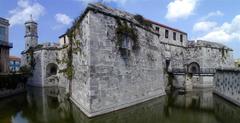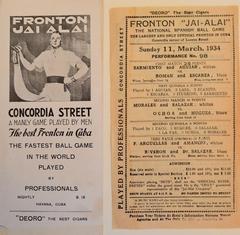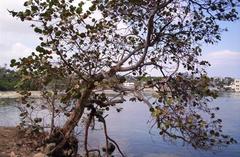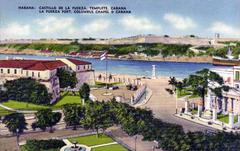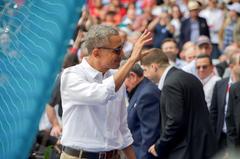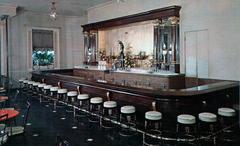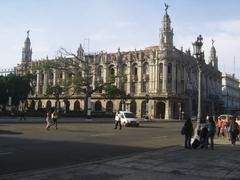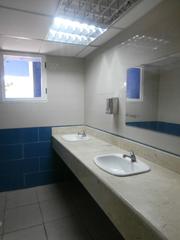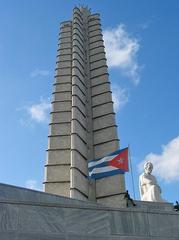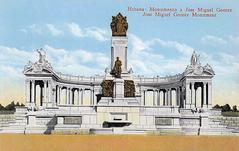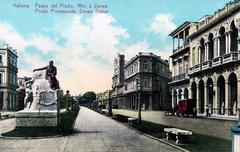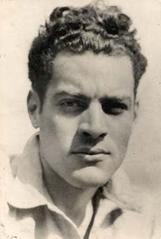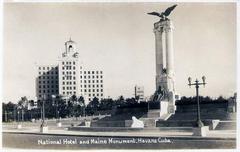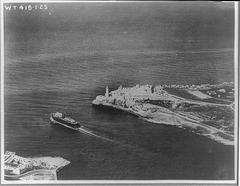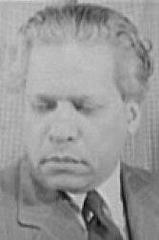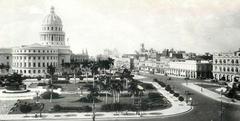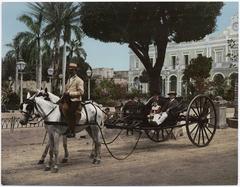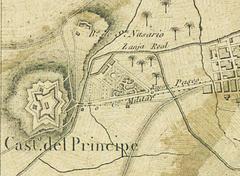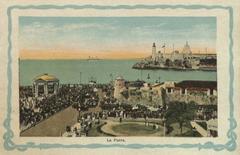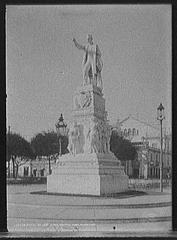
Antonio Maceo Monument Visiting Hours, Tickets, and Havana Historical Sites Guide
Date: 04/07/2025
Introduction
The Antonio Maceo Monument stands as one of Havana’s most iconic and meaningful landmarks, honoring General Antonio Maceo Grajales, “El Titán de Bronce” (The Bronze Titan). Located along the famed Malecón, this impressive memorial not only commemorates a national hero of Cuba’s wars of independence but also embodies enduring themes of freedom, racial equality, and unity. This detailed guide provides historical context, artistic insights, practical visitor information—including Antonio Maceo Monument visiting hours and accessibility—and travel tips for making the most of your visit to this essential Havana historical site.
Table of Contents
- Historical Context and Origins
- Artistic Features and Symbolism
- The Monument in Havana’s Urban Landscape
- Visiting the Antonio Maceo Monument
- Restoration and Preservation
- The Monument’s Role in Contemporary Cuban Identity
- Frequently Asked Questions (FAQ)
- Plan Your Visit
- References
Historical Context and Origins
Antonio Maceo Grajales (1845–1896) was a leading figure in Cuba’s struggle for independence from Spanish colonial rule. Born in Santiago de Cuba to a mixed-race family, Maceo rose through the ranks to become a brilliant general, celebrated for his tactical acumen, bravery, and unwavering commitment to Cuban liberation (Encyclopedia Britannica). His leadership in the Ten Years’ War (1868–1878) and the War of Independence (1895–1898), as well as his advocacy for racial equality, solidified his place in Cuban history.
After Maceo’s death in 1896, calls for a memorial grew, and the monument was officially inaugurated on May 20, 1916, at the historically significant site of the former Batería de la Reina, near Avenida Padre Varela and Calle San Lázaro (fotosdlahabana.com). Italian sculptor Doménico Boni’s design was selected for its ability to capture both the grandeur of Maceo’s legacy and the aspirations of a newly independent nation.
Artistic Features and Symbolism
Monument Structure
The Antonio Maceo Monument features a commanding bronze equestrian statue of Maceo, set atop a granite or marble pedestal. The statue presents Maceo in full military regalia, astride a rearing horse—a dynamic composition that conveys motion, leadership, and resilience (tripcuba.org). The materials—bronze and granite—were chosen for their durability, symbolizing the permanence of Maceo’s legacy.
Allegorical Figures and Reliefs
Around the base, four allegorical bronze figures represent Law, Justice, Thought, and Action, reflecting the core ideals of the independence movement. The pedestal is adorned with bas-reliefs depicting pivotal moments from Maceo’s life and Cuba’s wars of independence, including:
- Incorporation into the Ten Years’ War
- The Battle of La Indiana
- The Battles of Mangos de Mejía and Cacarajícara
- The Protest of Baraguá
These artistic elements serve to educate visitors and highlight the monument’s dual role as both art and history lesson (fotosdlahabana.com).
The Monument in Havana’s Urban Landscape
Situated within Parque Maceo, at the intersection of Malecón, San Lázaro, Marina, and Belascoaín, the monument occupies a pivotal space in Havana’s urban fabric (LaHabana.com). The park, developed several years after the monument’s unveiling, has undergone various renovations to enhance its accessibility and landscaping. Its location near the Malecón promenade, the Hotel Nacional de Cuba, the University of Havana, and other historical sites, ensures the monument’s high visibility and centrality to civic life.
Visiting the Antonio Maceo Monument
Hours and Tickets
- Visiting Hours: The monument and Parque Maceo are open daily from 7:00 AM to 7:00 PM (tripcuba.org).
- Admission: Free entry; no tickets required.
Accessibility
- The monument is wheelchair accessible, with paved pathways and ramps.
- Easily reachable on foot from the Malecón or by taxi and public transportation.
Travel Tips
- Best Time to Visit: Early morning or late afternoon for cooler temperatures and optimal lighting for photography.
- Nearby Attractions: Combine your visit with the Hotel Nacional de Cuba, University of Havana, or a stroll along the Malecón.
- Guided Tours: Multiple local operators include the monument in their Havana historical sites walking tours, offering valuable historical context.
Special Events and Photography
- The monument hosts official ceremonies on important national dates, including May 20th (inauguration anniversary) and July 26th (National Rebellion Day).
- Photographers can capture dramatic shots at sunrise or sunset, with the Malecón and Gulf of Mexico as a backdrop.
Restoration and Preservation
Major restoration efforts in 1938, 1960, 1996 (Maceo’s centenary), 2001, and 2007 have preserved the monument’s structure and artistic integrity (fotosdlahabana.com). These renovations have upgraded benches, fountains, and landscaping, ensuring the monument remains a vibrant gathering place.
The Monument’s Role in Contemporary Cuban Identity
Today, the Antonio Maceo Monument is a focal point for national ceremonies, educational visits, and artistic inspiration. Its symbolism continues to resonate, representing ideals of racial unity, justice, and sovereignty. The monument is frequently referenced in political speeches and cultural events, reinforcing its place in Cuba’s collective consciousness (LaHabana.com).
Frequently Asked Questions (FAQ)
Q: What are the Antonio Maceo Monument visiting hours?
A: The monument and Parque Maceo are open daily from 7:00 AM to 7:00 PM.
Q: Is there an entrance fee or tickets required?
A: Entry is free; no tickets are required.
Q: Is the site wheelchair accessible?
A: Yes, the monument and park have paved pathways and ramps.
Q: Are guided tours available?
A: Yes, many local operators include the monument in their historical walking tours.
Q: Can I take photographs at the monument?
A: Photography is encouraged, especially during early morning or late afternoon.
Q: How do I get there?
A: The monument is located at the intersection of Malecón and San Lázaro, accessible by taxi, bus, or on foot from central Havana.
Plan Your Visit
To fully experience the Antonio Maceo Monument:
- Visit during the cooler hours for comfort and the best photographic opportunities.
- Attend commemorative events for deeper cultural immersion.
- Explore nearby historical sites for a more comprehensive understanding of Havana’s layered history.
For guided tours, practical tips, and real-time updates, download the Audiala mobile app and follow us on social media.
Summary and Call to Action
The Antonio Maceo Monument is a powerful symbol of Cuban heritage, resilience, and unity. Its artistic grandeur, historical depth, and accessible location make it a must-see for any visitor to Havana. Plan your visit to engage with Cuba’s history, enjoy the vibrant atmosphere of the Malecón, and reflect on the enduring legacy of “El Titán de Bronce.”
Enhance your journey:
Download the Audiala app for guided audio tours and up-to-date travel information, and explore related Havana historical sites through our curated itineraries.
Visual Suggestions
- High-quality images of the Antonio Maceo Monument (alt text: “Antonio Maceo Monument in Havana at sunset”)
- Interactive map pinpointing the monument’s location along the Malecón
Internal and External Links
- See our guide: Top 10 Historical Sites in Havana
- Explore: A Traveler’s Guide to Havana’s Malecón
- LaHabana.com
- fotosdlahabana.com
- Lonely Planet
- Cuba Travel Guide
- Encyclopedia Britannica
- tripcuba.org
References
- Antonio Maceo Monument in Havana: Visiting Hours, Tickets, History, and Travel Tips, 2025, LaHabana.com
- Exploring the Antonio Maceo Monument: History, Artistry, and Visitor Guide in Havana, 2025, fotosdlahabana.com
- Antonio Maceo Monument Visiting Hours, Tickets, and Historical Significance in Havana, 2025, Lonely Planet
- Antonio Maceo Monument in Havana: Visiting Hours, Tickets & Historical Guide, 2025, Cuba Travel Guide
- Antonio Maceo - Biography, 2025, Encyclopedia Britannica
- Monument to Antonio Maceo Havana, 2025, tripcuba.org







